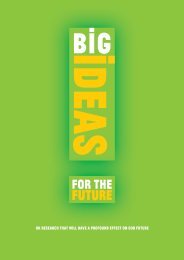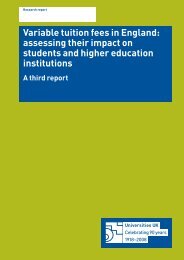Creating Prosperity: the role of higher education in ... - Universities UK
Creating Prosperity: the role of higher education in ... - Universities UK
Creating Prosperity: the role of higher education in ... - Universities UK
You also want an ePaper? Increase the reach of your titles
YUMPU automatically turns print PDFs into web optimized ePapers that Google loves.
<strong>Creat<strong>in</strong>g</strong> <strong>Prosperity</strong>: <strong>the</strong> <strong>role</strong> <strong>of</strong> <strong>higher</strong> <strong>education</strong><strong>in</strong> driv<strong>in</strong>g <strong>the</strong> <strong>UK</strong>’s creative economy32.0The contextDef<strong>in</strong><strong>in</strong>g <strong>the</strong> creative economy2.1 The term creative economy is <strong>in</strong>creas<strong>in</strong>gly used as a way <strong>of</strong> encapsulat<strong>in</strong>g a range <strong>of</strong> activities relatedto <strong>the</strong> central concept <strong>of</strong> <strong>the</strong> creative <strong>in</strong>dustries. The creative economy is broader than creative<strong>in</strong>dustries and might <strong>in</strong>clude, for example, culture and cultural tourism, <strong>the</strong> idea <strong>of</strong> creative cities,<strong>the</strong> creative class and even creativity itself.2.2 In l<strong>in</strong>e with <strong>the</strong> study’s terms <strong>of</strong> reference, <strong>the</strong> primary focus <strong>of</strong> <strong>the</strong> research was on <strong>the</strong> creative<strong>in</strong>dustries as <strong>the</strong> heart <strong>of</strong> <strong>the</strong> creative economy. However, <strong>the</strong> relationships between <strong>the</strong> creative<strong>in</strong>dustries and <strong>the</strong> wider economy rema<strong>in</strong> an important consideration.2.3 The Department for Culture, Media and Sport (DCMS) def<strong>in</strong>ed <strong>the</strong> creative <strong>in</strong>dustries as:‘those activities which have <strong>the</strong>ir orig<strong>in</strong> <strong>in</strong> <strong>in</strong>dividual creativity, skill and talent and which have apotential for wealth and job creation through <strong>the</strong> generation and exploitation <strong>of</strong> <strong>in</strong>tellectual property.’(DMCS, 1998)2.4 This def<strong>in</strong>ition was taken to <strong>in</strong>clude 13 sub-sectors (<strong>the</strong> DMCS 13), a classification that has provedremarkably durable and which is <strong>in</strong>creas<strong>in</strong>gly used as an <strong>in</strong>ternational benchmark. The 13 subsectorsare:advertis<strong>in</strong>g; architecture; <strong>the</strong> art and antique market; crafts; design; designer fashion; film;<strong>in</strong>teractive leisure s<strong>of</strong>tware; music; <strong>the</strong> perform<strong>in</strong>g arts; publish<strong>in</strong>g; s<strong>of</strong>tware; and televisionand radio.2.5 One <strong>of</strong> <strong>the</strong> most debated issues is <strong>the</strong> extent to which <strong>the</strong>se 13 sub-sectors represent a truly coherentset <strong>of</strong> <strong>in</strong>dustries, or are, <strong>in</strong> fact, more different than <strong>the</strong>y are similar. The DMCS 13 operate as subsectors<strong>in</strong> quite different ways with<strong>in</strong> <strong>of</strong>ten dist<strong>in</strong>ct and, <strong>in</strong> some cases well-established, supply cha<strong>in</strong>sand markets. While bus<strong>in</strong>ess models may share some common ground <strong>in</strong> content and copyright, <strong>the</strong>reare o<strong>the</strong>r differences that highlight specific <strong>in</strong>dustry conditions. For example, <strong>the</strong> primary revenuesource for commercial broadcast<strong>in</strong>g is advertis<strong>in</strong>g, while <strong>in</strong> computer games it is product sales(and, <strong>in</strong>creas<strong>in</strong>gly, onl<strong>in</strong>e subscriptions). Large parts <strong>of</strong> <strong>the</strong> design <strong>in</strong>dustries (for example graphics)operate more like pr<strong>of</strong>essional services, while arts organisations typically exist with<strong>in</strong> a mixedeconomy <strong>of</strong> public and commercial <strong>in</strong>come.2.6 It is also important to note that <strong>the</strong> creative <strong>in</strong>dustries do not sit <strong>in</strong> isolation from <strong>the</strong> rest <strong>of</strong> <strong>the</strong>economy. Many creative sub-sectors such as advertis<strong>in</strong>g, architecture, design and s<strong>of</strong>tware areprimarily <strong>in</strong>volved <strong>in</strong> bus<strong>in</strong>ess-to-bus<strong>in</strong>ess transactions, and <strong>the</strong> outputs <strong>of</strong> creative sectors f<strong>in</strong>dapplication across <strong>the</strong> economy. In fact, 55 per cent <strong>of</strong> creative products are purchased by o<strong>the</strong>rsectors (Work Foundation, 2007).2.7 The po<strong>in</strong>t here is that <strong>the</strong> creative <strong>in</strong>dustries are complex and it is important to bear <strong>in</strong> m<strong>in</strong>d <strong>the</strong>richness <strong>of</strong> <strong>the</strong>ir diversity. This presents both opportunities and challenges for <strong>the</strong> <strong>UK</strong> economyand for <strong>the</strong> <strong>role</strong> <strong>of</strong> <strong>higher</strong> <strong>education</strong> <strong>in</strong> support<strong>in</strong>g <strong>the</strong> sector.2.0 The context
















